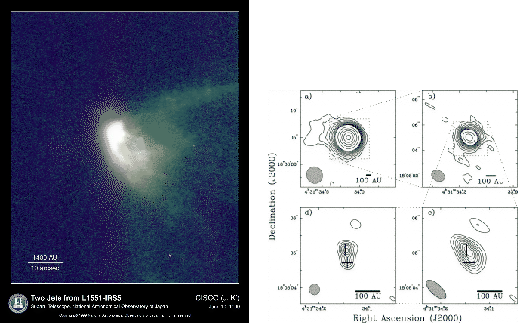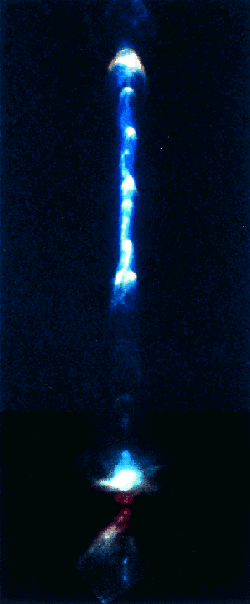



Next: L 1544: Pre-protostellar Cores
Up: L1551 IRS 5
Previous: Infall Motion
Contents
HST found two optical jets emanating from L1551 IRS5.
This has been observed by SUBARU telescope, which found jet emission is dominated by [FeII] lines in the J- and
H-bands.
The jet extents to the south-western direction and disappears at
 AU from the IRS5.
The width-to-length ratio is very small
AU from the IRS5.
The width-to-length ratio is very small
 or less, while the bipolar molecular outflow
shows a less collimated flow.
As for the origin of the two jets, these two jets might be ejected from a single source.
However, since there are at least two radio continuum sources in IRS5 within the mutual separation of
or less, while the bipolar molecular outflow
shows a less collimated flow.
As for the origin of the two jets, these two jets might be ejected from a single source.
However, since there are at least two radio continuum sources in IRS5 within the mutual separation of
 [see Fig.1.16 (right)],
these jets seem to be ejected from the two sources independently.
[see Fig.1.16 (right)],
these jets seem to be ejected from the two sources independently.
Figure 1.16:
(Left:) Infrared image (J- and K-band) of the IR reflection nebula around L1551 IRS5 by SUBARU telescope.
Taken from Fig.1 of Itoh et al. (2000).
(A jpeg file is available from the following url:
http://SubaruTelescope.org/Science/press_release/9908/L1551.jpg).
(Right:) Central 100 AU region map of L1551 IRS5.
This is taken by the  cm radio continuum observation.
Deconvolved map (lower-left) shows clearly that IRS5 consists of two sources.
Taken from Looney et al. (1997).
cm radio continuum observation.
Deconvolved map (lower-left) shows clearly that IRS5 consists of two sources.
Taken from Looney et al. (1997).
 |
Although the lengths of these jets are restricted to 10",
Herbig-Haro jets, which are much larger than the jets in L1551 IRS5, have been found.
HH30 has a  500 AU-scale jet whose emission is mainly from the shock-excited emission lines.
One of the largest ones is HH111, which is a member of the Orion star forming region and whose
distance is as large as
500 AU-scale jet whose emission is mainly from the shock-excited emission lines.
One of the largest ones is HH111, which is a member of the Orion star forming region and whose
distance is as large as  pc,
and a jet with a length of
pc,
and a jet with a length of  pc is observed.
Source of HH111 system is thought to consist of at least binary stars or possibly triple stars
[Reipurth et al (1999)].
Star A, which coincides with a
pc is observed.
Source of HH111 system is thought to consist of at least binary stars or possibly triple stars
[Reipurth et al (1999)].
Star A, which coincides with a  cm radio continuum source (VLA 1),
shows an elongation in the VLA map whose direction is parallel to the axis of the jet.
Therefore, star A is considered to be a source of the jet.
Since the VLA map of star A shows another elongated structure perpendicular to the jet axis,
star A may be a binary composed by two outflow sources.
cm radio continuum source (VLA 1),
shows an elongation in the VLA map whose direction is parallel to the axis of the jet.
Therefore, star A is considered to be a source of the jet.
Since the VLA map of star A shows another elongated structure perpendicular to the jet axis,
star A may be a binary composed by two outflow sources.
Figure 1.17:
A mosaic image of HH 111 based on HST NICMOS images (bottom) and WFPC2 images (top).
Taken from Fig.1 of Reipurth et al (1999).
 |




Next: L 1544: Pre-protostellar Cores
Up: L1551 IRS 5
Previous: Infall Motion
Contents
Kohji Tomisaka
2007-07-08


